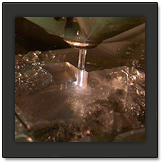Learn More About Our Sinker / Wire EDM / CNC Machining Capabilities

Steel 1 Company LLC has all the capabilities for any of your Sinker and Wire EDM or CNC machining project needs. Long or short run orders, prototype production, you name it we can do it.
Not only do we supply machine grade metal alloys, we offer Sinker, Wire EDM and CNC machining along with our other value added services. Our machinists, engineers and designers are equipped with the experience and dedication to quality and on time delivery of CNC, EDM, or Wire EDM machining projects every time. We also offer Blanchard Grinding, custom Metal Fabrication, Flame – Laser – Plasma Cutting, Hollow Bar – Seamless Mechanical Tubing, Mattison Grinding and Saw Cutting as value added services.
Why Choose CNC Machining
CNC Machining is a good choice when you need to hold tight tolerances (+/- 0.0005″). Because CNC is a subtractive process, it can be used on almost any type of Aluminum and Steel alloys including production grade plastic. All you need to do for CNC Machining is select your material, call out your various tolerances and send over your CAD data.
We supply both prototype and production run CNC Machining. No matter if you are looking for a production run or just a few components, we pride ourselves on providing high quality machine tooled parts.
What is CNC Machining
CNC stands for Computer Numerical Control. CNC machining is a high speed way of removing material from a part in order to obtain the desired final machined part. CNC Machining can run unattended in a 24/7 situation which is ideal for high volume production runs. Using today’s latest technologies CNC Machining is faster and more accurate than ever before, insuring the highest quality and shortened lead-times.
In Most Cases 1 – 2 Days Turnaround
Tolerances Depending on Material +/- .0005
Wide Range of Materials Available
Why Choose Sinker Machining
Sinker EDM is also known as EDM Machining and its a great choice when your design requires a sharp corner or a a part geometry that is more economical than CNC Machining. A CNC cutter will leave a radius when it is cutting, which makes it impossible to have a design that requires a sharp corner. Sinker EDM is a versatile process, allowing for a variety of sized parts from those that can fit in the palm of a hand to parts that weigh over 1,000 pounds. Certain parts can only be produced using Sinker EDM, which, unlike Wire EDM usually doesn’t cut all the way through the part.
What is Sinker Machining
Sinker EDM is also a form of EDM Machining. This type of machining uses electrical currents to ‘burn” a geometry into a metal alloy using an electrically charged electrode. The electrode is configured to a specific geometry in order to burn the geometry of the electrode into a metal component.
Why Choose Wire EDM Machining
If you are looking for accurately repeatable results that are more economical than conventionally machined parts, Wire EDM Machining might be the solution for your project. Wire EDM does cut all the way through a metal alloy unlike the usual Sinker EDM which normally is configured to cut partially through a metal alloy.
The best projects for Wire EDM machining pose one or more specific challenges like tight-radius inside corners, tight slots, or difficult to machine materials, these can be hardened parts or a high performance alloy. Wire EDM Machining is also used for parts that because of quality requirements can not have any burrs or other imperfections and / or need a superior surface finish. Wire EDM can easily machine complex parts and precision components out of metal alloys.
What is Wire EDM Machining
Wire EDM (Wire Electrical Discharge Machine) is not a new process as it has been used in Manufacturing for around 50 years. The wire is used as the electrode, stretched taut and then submerged in deionized water along with the work piece. The water acts as dialectic until the electric discharge happens. As the wire moves toward the material to cut and the distance gets smaller, the voltage increases and a spark is created between the wire and the material. The heat caused by this electric discharge enables the wire to cut through the material.
